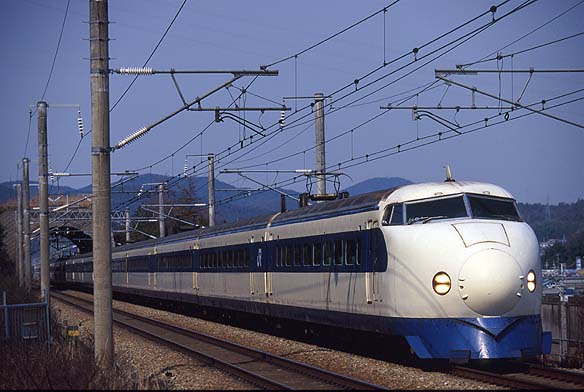0 series entered the service in 1964 with the start of operations on the
Tokaido Shinkansen. 3216 vehicles were built over the period from 1963
until 1986. The vehicles were constructed by steel with wide windows.
The nose profile is streamline that is similar to that of the DC-8 airliner.
Bodies are longer and wider than those of conventional trains running on
the 1067mm narrow gauge. Vehicles except some vehicles are equipped with
2 doors on each side of the body, because there are many passengers boarding
or alighting. The vehicle design incorporates pressure cabin to reduce
the fluctuation of atmospheric pressure in the passenger room.
0 series adopt the distributed traction system. All cars were powered to give a maximum service speed of 210 km/h. 0 series adopt 2 cars unit. Vehicles of the odd number types are equipped with the traction system, and vehicles of the even number types are equipped with the transformer and the rectifier. Since each unit is fitted with the cross-arm pantograph, a 16-car formation is fitted with 8 current collectors.
Bogies called DT200 adopt direct mounted air spring. Journal box supporting
system is IS which is improved "Minden- deuty". Axle spacing
is 2500mm for improved stability at 210km/h running.
Standard class accommodation is in the normal Shinkansen 2+3 configuration,
and first class accommodation is in 2+2. Seats in standard class are switchable,
and those in first class are adjustable reclining. Seat pitch is 960mm
in standard class, and 1160mm in first class. Standard class accommodation
is changed into upgraded simple reclining seats, which are two-position
"slide-and-recline" type. Unlike the two-abreast seats, the three-abreast
seats do not rotate, and so are arranged facing away from the center of
the car. Although 0 series included only buffet cars at the beginning,
restaurant cars were added when the Sanyo Shinkansen was extended to Hakata.
The air conditioners named AU56 adopt the heat pump system.
The maximum speed was raised to 220 km/h in 1986 although it was 210km/h
at the beginning. 0 series vehicles with wide windows were gradually displaced
with 100 series or later series after the splitting of the former Japanese National Railways
(JNR) into the new privatized JR companies and finally withdrawn in 1999. |
|
| Technical Data |
| Items |
Data |
| Built |
1963-1976 |
| Construction |
Steel |
| Formation |
4M, 6M,
12M, 16M |
| Supply
voltage |
25,000VAC,
60Hz |
| Service
speed, etc. |
Acceleration:
0.96km/h/s Service speed: 220km/h |
| Length |
25,150mm
(End cars) 25,000mm (Intermediate cars) |
| Width |
3,383mm |
| Height |
3,975mm |
| Bogie |
DT200 |
| Collector |
PS200 Cross-arm
(8 per 16-car train) |
| Traction
motor |
MT200A (185kW, -1972), MT200B (185kW, 1972-1976) |
| Gear ratio |
2.17 |
| Transformer |
TM200 (-1974), TM201 (1974-1976) |
| Rectifier |
RS200 (-1972), RS200A (1973-1976) |
| Controller |
CS21 |
| Air conditioner |
AU56 |
| Designed by |
Japan National Railways |
|
|

